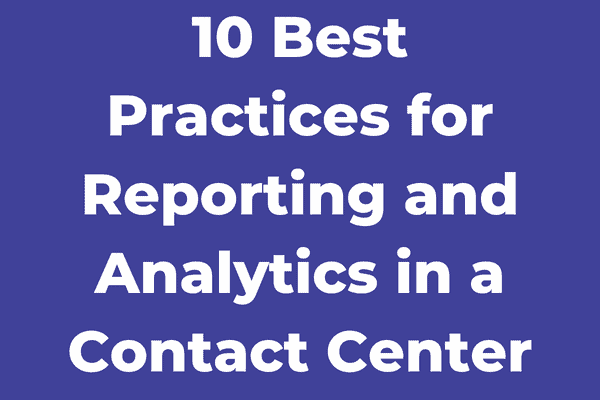The Importance of Reporting and Analytics in a Contact Center
Reporting and analytics are crucial components that help gain an accurate and sincere state of a contact center’s development. It is the process of collecting and analyzing data about the performance and operations of a contact center to gain insight and identify improvement areas.
On the one hand, reporting refers to data collection on various metrics, such as customer satisfaction, call volume, agent performance, and other relevant KPIs. They are presented using reports to monitor a contact center’s performance over time. On the other hand, analytics refers to using advanced tools and techniques to analyze the collected data. It is pivotal to contact centers as it provides deeper insights that will help identify trends and improvement areas that might be inconspicuous from the raw data.
In tandem, reporting and analytics help managers make data-driven decisions that improve a contact center’s performance and reduce costs. Additionally, they help identify improvement areas and ensure the strategic goals are met.
How Reporting and Analytics Improve Contact Centers
Reporting and analytics permit deciders to make well-informed decisions and address inefficiencies in operations. By tracking the relevant metrics, contact center managers ensure they are on the right path to reaching their objectives.
Reporting and analytics improve contact centers in several ways, as they allow to:
- Identify areas for improvement:
Through data analysis on relevant metrics, contact centers can identify areas where they need to improve their operations. This usually includes optimizing staffing levels, improving agent performance, and implementing new technologies to better service customers.
- Optimize staffing:
Through analytics, managers can identify peak call times and volumes, allowing them to schedule agents efficiently. This reduces customer wait time, improving the experience and increasing customer satisfaction.
- Enhance customer satisfaction:
Contact centers gain valuable insight into the customer experience through data collection on customer interactions and feedback. This allows them to identify improvement areas like call routing and other new technologies. That’s also true for staff improvement, such as training agents on handling specific types of calls.
- Improve efficiency:
Reporting and analytics help managers identify inefficiencies and take preventive measures. For example, by analyzing call duration metrics, it is possible to identify long calls and intervene to reduce AHT.
Talking about efficiency, our Omnichannel Contact Center Software is a champion of contact center optimization, boosting efficiency for contact centers worldwide. With its intuitive interface and built-in analytics and reporting engine, it is the go-to solution for contact centers to improve their efficiency and ensure the accuracy and exactitude of collected data.
- Meet goals and objectives:
By tracking relevant metrics, contact centers can ensure they are on the right path to meet their goals and objectives. This enables managers to make data-driven decisions and consequently improve performance.
Reporting and analytics tools help contact centers improve operations, enhance customer satisfaction, and meet their goals and objectives.
Contact centers gain insights into their operations and optimize performance by collecting and analyzing data on various metrics.
The following chapter will discuss the benefits of tracking key performance indicators.
The Benefits of Tracking Key Performance Indicators
Tracking key performance indicators is the root of proper decision-making. Ensuring your contact center properly tracks and analyzes these metrics is crucial in maintaining productivity and enhancing customer experience. The following is a list of the main benefits of tracking KPIs.
• Improving customer experience:
Contact centers can ensure they meet customer needs and expectations by tracking and analyzing indicators such as First Call Resolution rate (FCR) and Customer Satisfaction Score (CSAT). In addition, through monitoring and optimizing these KPIs, contact center managers can improve the overall customer experience and satisfaction.
• Increasing efficiency:
Tracking KPIs related to a contact center’s performance, such as service level, occupancy rate, and adherence, helps managers measure how efficiently they use resources. As a result, contact centers can increase their efficiency and lower operating costs by tracking and optimizing these KPIs.
• Enhancing agent performance:
Contact centers can evaluate agents’ performance and identify lagging areas where coaching and training are needed by tracking the relevant KPIs, such as Average Handling Time (AHT), Call Abandonment Rate, and Quality scores. As a result, managers can enhance their agents’ performance and productivity by monitoring and improving them.
• Making data-driven decisions:
By tracking KPIs, contact centers can gain valuable insights into their operations and identify areas where improvements can be made. These insights can help contact center managers make data-driven decisions and prioritize their efforts for maximum impact.
• Monitoring business goals:
KPIs can track progress toward business goals such as revenue growth, cost reduction, and customer retention. By monitoring these KPIs, managers ensure they are on track to meet their business goals and make adjustments as needed.
10 Best Practices for Reporting and Analytics in a Contact Center
Reporting and analytics constitute an important prerequisite to making well-informed and accurate decisions and projections in any business. And contact centers are no exception. Ensuring that the efforts invested in these activities follow the right path is a must.
The following are 10 of the best practices to ensure the accuracy and the proper handling of reporting and analytics:
1. Define Clear Goals and Objectives:
This is one of the utmost important phases concerning reporting and analytics. Clear and well-defined goals and objectives help managers focus on relevant metrics. By clearly understanding what the contact center wants to achieve and asking questions such as “What do we want to achieve through reporting and analysis?” managers can conceive a set of relevant metrics to track.
When the goals and objectives are well defined, it becomes easy to determine which data should go through the collection and analysis process. For example, if the goal is to increase customer satisfaction, contact centers would track metrics related to customer satisfaction, such as CSAT, FCR, and AHT. By emphasizing these metrics, you will better depict customer satisfaction and reveal areas that need improvement.
Additionally, having well-defined goals and objectives ensure that the data collected is accurate and relevant. Without a clear outline of what you are measuring and why it is burdensome to distinguish the good and relevant data from those that aren’t.
By having a clear and defined goal, you can avoid collecting irrelevant and misleading data.
3. Identify Key Performance Indicators (KPIs)
KPIs, or Key Performance Indicators, measure a contact center’s success in achieving its goals and objectives. By identifying the right metrics, we gain valuable operation insights, which optimize performance and enhance customer experience.
Identifying the relevant KPIs ensures the contact center tracks the right metrics. They should directly link to the fixed goals and objectives, emphasizing that they need to be carefully selected.
Moreover, KPIs provide a consistent framework for measuring performance to track progress over time, identify trends, and make data-driven decisions. This helps contact centers pinpoint their strength and weaknesses areas.
Also, by tracking KPIs used in the industry, contact centers can compare their performance to peers to identify strengths and build on them, diagnose weaknesses, and remedy them. Benchmarking can also help set realistic performance goals and provide a solid ground for performance-based actions.
We discuss KPIs and how to properly identify and analyze them in our article “10 essential KPIs for measuring contact center performance.”
3. Implement Real-time Reporting
Real-time reporting is a game-changing aspect of reporting and analytics. It enables contact centers to respond rapidly to changing needs, identify improvement areas, and swiftly make decisions.
By drawing real-time data, managers quickly identify trends, patterns, and issues that impact performance or customer experience. This enables them to swiftly respond and make informed decisions to remedy the predicaments before they escalate.
Real-time reporting enables contact centers to optimize their operations in real time. For example, when call volumes face an unexpected surge, it can help managers quickly adjust staffing, change routing rules, and initiate other tactics to handle unexpected occurrences.
Additionally, real-time reporting improves performance monitoring. By receiving real-time data, managers quickly identify where performance is suffering and take immediate action to remedy it. It also facilitates continuous improvement by allowing managers to identify improvement areas and adjust processes to optimize performance rapidly. This enables them to continuously improve the customer experience and remain competitive in a rapidly changing environment.
4. Use Data Visualization Tools
Data visualization refers to the graphical representation of data. It helps contact centers turn complex data sets into visual representations that are easier to understand and analyze.
Data visualization tools help identify patterns and trends more quickly. Managers can identify patterns, trends, and anomalies that might not be apparent from a tabular report. This helps to quickly identify areas that require further analysis and pinpoint issues that impact performance or customer experience.
Moreover, data visualization tools help improve communication and collaboration by presenting data in a visually compelling format. This allows managers to easily communicate complex information to stakeholders, facilitating collaboration across different teams and departments.
Data visualization tools provide context and meaning to data, making it easier to understand and interpret. They also identify insights and opportunities that might not be apparent from a tabular report and facilitate more informed decision-making.
Data visualization tools also help improve data accuracy and completeness so that managers can easily identify data anomalies and outliers that might indicate omissions in the data.
5. Ensure Data Accuracy and Consistency
No reporting and analytics endeavors are worth the effort if the data lacks accuracy and consistency.
When data is inaccurate or inconsistent, it is difficult to identify trends in the data that affect performance or customer experience. Ensuring the collected data is accurate and consistent enables contact center managers to take appropriate actions to address issues and optimize performance.
Moreover, accurate and consistent data helps to facilitate benchmarking and comparison. When data is inaccurate or inconsistent, it can be difficult to benchmark performance against industry standards or compare performance across different teams or departments.
Accurate and consistent data also improves forecasting and planning. It is impossible to forecast future trends and plan for future operations with inaccurate data.
Additionally, when data is inaccurate or inconsistent, stakeholders may be less likely to trust and make decisions based on it. Managers can build trust in data-driven decision-making, increasing buy-in and support for data-driven initiatives.
6. Incorporate Agent Feedback
Agents reside on the front line of customer interactions. They possess valuable insights into customer needs, pain points, and preferences. Therefore, incorporating agent feedback significantly improves reporting and analytics efforts in a contact center.
Since they are the front line of customer interaction, agents are usually the first to pick up patterns and trends that may impact performance or customer experience. Their feedback helps improve agent engagement and satisfaction. When they feel valued and their feedback is acted upon, agents become more engaged and satisfied with their work, leading to improved agent performance and reduced turnover rates.
Agent feedback also improves customer experience, while managers can gain insights into customer needs and preferences, enabling them to tailor their operations to better meet these needs. This leads to a more personalized and positive customer experience, improving customer satisfaction and loyalty.
Additionally, agent feedback helps to identify training and coaching needs. Managers identify areas where agents require additional training or coaching for performance improvement. This usually improves agent skills and knowledge, leading them to improve their performance and enhance the customer experience.
7. Analyze Customer Feedback
Like agent feedback, customer feedback yields insight into their needs, pain points, and preferences, enabling managers to optimize operations and enhance customer experience.
Customer feedback helps to measure customer satisfaction and loyalty and identify improvement areas. Thus, managers can measure customer satisfaction and loyalty, enabling them to identify improvement areas and take appropriate action to remedy weaknesses.
Additionally, customer feedback helps to identify emerging trends and opportunities and inform product and service development. Consequently, managers can identify emerging trends and opportunities in the market and gain insights into customer needs and preferences – enabling them to stay ahead of the competition, deliver a differentiated customer experience, and develop new products and services that better meet these needs.
8. Continuously Monitor and Improve Performance
Contact centers can identify and address real-time issues by continuously monitoring and improving performance. Managers quickly identify areas where performance is lagging and take appropriate action to address these issues.
It also enables contact center managers to optimize how resources are allocated. Through this, they can identify trends in customer interactions and optimize resource allocation to meet changing customer needs.
Moreover, continuously monitoring and improving performance enables contact center managers to identify agents and teams performing exceptionally well – and leverage their best practices to improve overall performance.
Lastly, it allows managers to measure the effectiveness of training and coaching programs. This enables them to make data-driven decisions about how to optimize these programs.
9. Regularly Share Results and Insights
By regularly sharing results and insights, managers can identify and address performance issues in real time and allocate resources optimally.
It enables contact center managers to identify and take profit from best practices. This helps managers identify agents and teams performing exceptionally well and leverage their best practices to improve overall performance.
Moreover, it enables managers to assess the success of training and coaching programs, allowing them to make well-informed decisions about optimizing these programs.
10. Invest in Training and Development
Well-trained agents are better equipped to handle customer interactions effectively and efficiently, improving customer satisfaction and loyalty. This, in turn, improves the quality of data collected by the contact center, which is critical for accurate reporting and analytics.
Investing in training and development also reduces agent turnover. It demonstrates to agents that the organization values their development and growth, directly improving their job satisfaction and reducing turnover. This drastically reduces the need to hire and train new agents, resulting in an experienced workforce better equipped to handle interactions and collect accurate data.
Moreover, it ensures consistency in data collection. Standardized training programs ensure that all agents consistently collect data, resulting in more accurate and reliable data. This also improves the quality of reporting and analytics.
Lastly, investing in training and development improves the effectiveness of coaching programs. Well-trained coaches are qualified to provide effective coaching to agents, resulting in improved agent performance.
Conclusion
The best practices developed in this article are essential for businesses to enhance their customer experience and optimize their operations. These practices incorporate data collection and analysis, establishing performance metrics, providing feedback, and leveraging technology to automate reporting processes. Additionally, companies should prioritize transparency and cross-department communication to ensure that insights are shared effectively, and actions are taken to improve overall performance.
Investing in the right technology is a cornerstone in implementing self-service options – technology like OMNI+ offers remarkable features and an easy-to-use interface. Helping agents provide seamless customer interactions by freeing up their time through self-service capabilities can be integrated into any inbound scenario.
By implementing these best practices, businesses can gain a deeper understanding of customer needs and behaviors, improve agent productivity and efficiency, and ultimately, drive business growth and success.

Andrei is an experienced marketing professional specializing in propelling growth for both B2B and B2C companies. Proficient in streamlining marketing operations and enhancing lead and customer experiences through SEO and marketing techniques.







